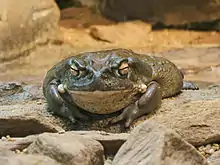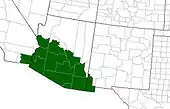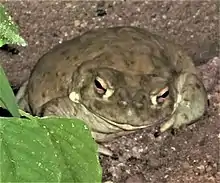Colorado River toad
The Colorado River toad (Incilius alvarius), also known as the Sonoran Desert toad, is found in northern Mexico and the southwestern United States. Its toxin, as an exudate of glands within the skin, contains 5-MeO-DMT and bufotenin.
| Colorado River toad | |
|---|---|
 | |
_(8-6-13)_78_circulo_montana%252C_patagonia_lake_ranch_estates%252C_scc%252C_az_-01_(9466158294).jpg.webp) | |
| Scientific classification | |
| Kingdom: | Animalia |
| Phylum: | Chordata |
| Class: | Amphibia |
| Order: | Anura |
| Family: | Bufonidae |
| Genus: | Incilius |
| Species: | I. alvarius |
| Binomial name | |
| Incilius alvarius | |
 | |
| Synonyms | |
|
Ollotis alvaria (Frost, 2006) | |
Description
The Colorado River toad can grow to about 190 millimetres (7.5 in) long and is the largest toad in the United States apart from the non-native cane toad (Rhinella marina). It has a smooth, leathery skin and is olive green or mottled brown in color. Just behind the large golden eye with horizontal pupil is a bulging kidney-shaped parotoid gland. Below this is a large circular pale green area which is the tympanum or ear drum. By the corner of the mouth there is a white wart and there are white glands on the legs. All these glands produce toxic secretions. Its call is described as, “a weak, low-pitched toot, lasting less than a second.”[2]
Dogs that have attacked toads have suffered paralysis or even death. Raccoons have learned to pull a toad away from a pond by the back leg, turn it on its back and start feeding on its belly, a strategy that keeps the raccoon well away from the poison glands.[3] Unlike other vertebrates, this amphibian obtains water mostly by osmotic absorption across its abdomen. Toads in the family bufonidae have a region of skin known as "the seat patch", which extends from mid abdomen to the hind legs and is specialized for rapid rehydration. Most of the rehydration is done through absorption of water from small pools or wet objects.[4]
Distribution and habitat

The Colorado River toad is found in the lower Colorado River and the Gila River catchment areas, in southeastern California, New Mexico, Mexico and much of southern Arizona. It lives in both desert and semi-arid areas throughout its range. It is semiaquatic and is often found in streams, near springs, in canals and drainage ditches, and under water troughs.[3] The Colorado River toad is known to breed in artificial water bodies (e.g., flood control impoundments, reservoirs) and as a result, the distributions and breeding habitats of these species may have been recently altered in south central Arizona.[5] It often makes its home in rodent burrows and is nocturnal.
Biology
The Colorado River toad is sympatric with the spadefoot toad (Scaphiopus spp.), Great Plains toad (Anaxyrus cognatus), red-spotted toad (Anaxyrus punctatus), and Woodhouse's toad (Anaxyrus woodhousei). Like many other toads, they are active foragers and feed on invertebrates, lizards, small mammals, and amphibians. The most active season for toads is May–September, due to greater rainfalls (needed for breeding purposes). The age of I. alvarius individual in a population at Adobe Dam in Maricopa County, Arizona ranged from 2 to 4 years; other species of toads have a lifespan of 4 to 5 years.[6] The taxonomic affinities of I. alvarius remain unclear, but immunologically, it is similarly close to the boreas and valliceps groups.[7]
Breeding
The breeding season starts in May, when the rainy season begins, and can last up to August. Normally, 1–3 days after the rain is when toads begin to lay eggs in ponds, slow-moving streams, temporary pools or man-made structures that hold water. Eggs are 1.6 mm in diameter, 5–7 cm apart, and encased in a long single tube of jelly with a loose but distinct outline. The female toad can lay up to 8,000 eggs.[8]
Psychotropic uses
The toad's primary defense system are glands that produce a poison that may be potent enough to kill a grown dog.[9] These parotoid glands also produce the 5-MeO-DMT[10] and Bufotenin (which is named after the Bufo genus of toads); both of these chemicals belong to the family of hallucinogenic tryptamines. When vaporized, a single deep inhalation of the poison produces strong psychoactive effect within 15 seconds.[11] After inhalation, the user usually experiences a warm sensation, euphoria, and strong visual and auditory hallucinations, due to 5-MeO-DMT's high affinity for the 5-HT2 and 5-HT1A serotonin receptor subtypes.[12]
Bufotenin is a chemical constituent in the secretions and eggs of several species of toads belonging to the genus Bufo, but the Colorado River toad (Incillius alvarius) is the only toad species in which bufotenin is present in large enough quantities for a psychoactive effect. Extracts of toad secretion, containing bufotenin and other bioactive compounds, have been used in some traditional medicines such as ch’an su (probably derived from Bufo gargarizans), which has been used medicinally for centuries in China.[13]
The toad was "recurrently depicted in Mesoamerican art",[14] which some authors have interpreted as indicating that the effects of ingesting Bufo secretions have been known in Mesoamerica for many years; however, others doubt that this art provides sufficient "ethnohistorical evidence" to support the claim.[13]
In addition to bufotenin, Bufo secretions also contain digoxin-like cardiac glycosides, and ingestion of the poison can be fatal. Ingestion of Bufo toad toxins and eggs by humans has resulted in several reported cases of poisoning,[15][16][17] some of which resulted in death.[17][18][19]
Contemporary reports indicate that bufotenin-containing toad toxins have been used as a street drug; that is, as a supposed aphrodisiac,[20] ingested orally in the form of ch’an su,[17] and as a psychedelic, by smoking or orally ingesting Bufo toad secretion or dried Bufo skins. The use of chan'su and love stone (a related toad toxin preparation used as an aphrodisiac in the West Indies) has resulted in several cases of poisoning and at least one death.[17][21] The practice of orally ingesting toad secretions has been referred to in popular culture and in the scientific literature as toad licking and has drawn media attention.[22] Albert Most, founder of the Church of the Toad of Light and a proponent of spiritual use of Colorado River Toads, published a booklet titled Bufo alvarius: The Psychedelic Toad of the Sonoran Desert[23][24] in 1983 which explained how to extract and smoke the secretions.
State laws

The toads received national attention in 1994 after The New York Times Magazine published an article about a California teacher who became the first person to be arrested for possessing secretion of the toads.[25][26] Dean Heiser experimented, and has done extensive research regarding the chemical compound molecules held together by covalent bonds. The substance concerned, bufotenin, had been outlawed in California since 1970.[27]
In November 2007, a man in Kansas City, Missouri was discovered with an I. alvarius toad in his possession, and charged with possession of a controlled substance after they determined he intended to use its secretions for recreational purposes.[28][29] In Arizona, one may legally bag up to 10 toads with a fishing license, but it could constitute a criminal violation if it can be shown that one is in possession of this toad with the intent to smoke its secretions.[30]
None of the U.S. states in which I. alvarius is or was indigenous – California, Arizona, and New Mexico – legally allows a person to remove the toad from the state. For example, the Arizona Game and Fish Department is clear about the law in Arizona: "An individual shall not...export any live wildlife from the state; 3. Transport, possess, offer for sale, sell, sell as live bait, trade, give away, purchase, rent, lease, display, exhibit, propagate...within the state."[30]
In California, I. alvarius has been designated as "endangered" and possession of this toad is illegal. "It is unlawful to capture, collect, intentionally kill or injure, possess, purchase, propagate, sell, transport, import or export any native reptile or amphibian, or part thereof..."[31]
In New Mexico, this toad is listed as "threatened" and taking I. alvarius is unlawful in that state.[32][33]
References
Notes
- "The IUCN Red List of Threatened Species". IUCN Red List of Threatened Species. Retrieved 2018-10-27.
- National Audubon Society: Field Guide to Reptiles and Amphibians
- Badger, David; Netherton, John (1995). Frogs. Shrewsbury, England: Swan Hill Press. pp. 93–94. ISBN 1-85310-740-9.
- Zoological Science. Zoological Society of Japan. pp. 664–670. doi:10.2108/zsj.28.664. S2CID 207287044.
- Gergus, Erik W. A.; Malmos, Keith B.; Sullivan, Brian K. (1999). "Natural hybridization among distantly related toads (Bufo alvarius, Bufo cognatus, Bufo woodhousii) in Central Arizona". Copeia. 1999 (2): 281–286. doi:10.2307/1447473. JSTOR 1447473.
- "Lower Colorado River Multi-Species Conservation Program". September 2008: 330–342. Cite journal requires
|journal=(help) - Sullivan, Brian K.; Malmos, Keith B.; Movin, T. (1994). "Call variation in the Colorado River Toad (Bufo alvarius): behavioral and phylogenetic implications". Herpetologica. 50 (2): 146–156. doi:10.1007/BF00690963. JSTOR 3893021. PMID 3893021. S2CID 22694946.
- Behler, J.L (1979). The Audubon Society Field Guide to North American Reptiles and Amphibians. Knopf; 1 edition (November 12, 1979). pp. 743. ISBN 0394508246.
- Phillips, Steven J.; Wentworth Comus, Patricia, eds. (2000). A Natural History of the Sonoran Desert. University of California Press. p. 537. ISBN 0-520-21980-5.
- Erspamer, V.; Vitali, T.; Roseghini, M.; Cei, J.M. (July 1967). "5-Methoxy- and 5-Hydroxyindoles in the skin of Bufo alvarius" (PDF). Biochemical Pharmacology. 16 (7): 1149–1164. doi:10.1016/0006-2952(67)90147-5. PMID 6053590.
- Weil, Andrew T.; Davis, Wade (January 1994). "Bufo alvarius: a potent hallucinogen of animal origin". Journal of Ethnopharmacology. 41 (1–2): 1–8. doi:10.1016/0378-8741(94)90051-5. PMID 8170151.
- Krebs-Thomson, Kirsten; Ruiz, ErbertM.; Masten, Virginia; Buell, Mahalah; Geyer, MarkA. (December 2006). "The roles of 5-HT1A and 5-HT2 receptors in the effects of 5-MeO-DMT on locomotor activity and prepulse inhibition in rats". Psychopharmacology. 189 (3): 319–329. doi:10.1007/s00213-006-0566-1. ISSN 0033-3158. PMID 17013638. S2CID 23396616.
- Davis W, Weil A (1992). "Identity of a New World Psychoactive Toad". Ancient Mesoamerica. 3: 51–9. doi:10.1017/s0956536100002297.
- Kennedy AB (1982). "Ecce Bufo: The Toad in Nature and in Olmec Iconography". Current Anthropology. 23 (3): 273–90. doi:10.1086/202831. S2CID 143698915.
- Hitt M, Ettinger DD (1986). "Toad toxicity". N Engl J Med. 314 (23): 1517–8. doi:10.1056/NEJM198606053142320. PMID 3702971.
- Ragonesi DL (1990). "The boy who was all hopped up". Contemporary Pediatrics. 7: 91–4.
- Brubacher JR, Ravikumar PR, Bania T, Heller MB, Hoffman RS (1996). "Treatment of toad venom poisoning with digoxin-specific Fab fragments". Chest. 110 (5): 1282–8. doi:10.1378/chest.110.5.1282. PMID 8915235.
- Gowda RM, Cohen RA, Khan IA (2003). "Toad venom poisoning: resemblance to digoxin toxicity and therapeutic implications". Heart. 89 (4): 14e–14. doi:10.1136/heart.89.4.e14. PMC 1769273. PMID 12639891.
- Lever, Christopher (2001). The Cane Toad: The History and Ecology of a Successful Colonist. Westbury Academic & Scientific Publishing. ISBN 978-1-84103-006-7.
- Rodrigues, R.J. Aphrodisiacs through the Ages: The Discrepancy Between Lovers’ Aspirations and Their Desires. ehealthstrategies.com
- Centers for Disease Control and Prevention (CDC) (1995). "Deaths associated with a purported aphrodisiac—New York City, February 1993 – May 1995". MMWR Morb Mortal Wkly Rep. 44 (46): 853–5, 861. PMID 7476839.
- The Dog Who Loved to Suck on Toads. NPR. Accessed on May 6, 2007.
- Most, A. "Bufo avlarius: The Psychedelic Toad of the Sonoran Desert". erowid.org. Retrieved 2007-08-12.
- How ‘bout them toad suckers? Ain’t they clods? Archived September 28, 2011, at the Wayback Machine Smoky Mountain News. Accessed on May 6, 2007
- "Missionary for Toad Venom Is Facing Charges". The New York Times. 20 February 1994.
- "Couple Avoid Jail In Toad Extract Case". The New York Times. 1 May 1994.
- Bernheimer, Kate (2007). Brothers & beasts: an anthology of men on fairy tales. Wayne State University Press. pp. 157–159. ISBN 978-0-8143-3267-2.
- "'Toad Smoking' Uses Venom From Angry Amphibian to Get High". FOX News. Kansas City. 3 December 2007.
- Shelton, Natalie (7 November 2007). "Drug sweep yields weed, coke, toad". KC Community News. Archived from the original on 14 December 2007.
- AZGFD.gov Archived 2008-01-11 at the Wayback Machine
- "Title 14. Division 1. Subdivision 1. Chapter 5., § 40(a)".
- 19.33.6 NMAC Archived 2016-03-04 at the Wayback Machine. nmcpr.state.nm.us
- 19.35.10 NMAC Archived 2012-09-10 at the Wayback Machine. nmcpr.state.nm.us
Further reading
- Frost, Darrel R.; Grant, Taran; Faivovich, JuliÁN; Bain, Raoul H.; Haas, Alexander; Haddad, CÉLIO F.B.; De SÁ, Rafael O.; Channing, Alan; Wilkinson, Mark; Donnellan, Stephen C.; Raxworthy, Christopher J.; Campbell, Jonathan A.; Blotto, Boris L.; Moler, Paul; Drewes, Robert C.; Nussbaum, Ronald A.; Lynch, John D.; Green, David M.; Wheeler, Ward C.; et al. (2006). "The Amphibian Tree of Life". Bulletin of the American Museum of Natural History. 297: 1–370. doi:10.1206/0003-0090(2006)297[0001:TATOL]2.0.CO;2.
- Pauly, G. B.; Hillis, D. M.; Cannatella, D. C. (2004). "The history of a Nearctic colonization: Molecular phylogenetics and biogeography of the Nearctic toads (Bufo)". Evolution. 58 (11): 2517–2535. doi:10.1111/j.0014-3820.2004.tb00881.x. PMID 15612295. S2CID 10281132.
External links
| Wikispecies has information related to Incilius alvarius. |
